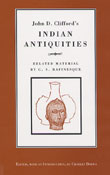John Cliffords Indian Antiquities
Related Material By C.S. Rafinesque

- Author(s): Author Charles Boewe
- Series:
- Imprint: Univ Tennessee Press
- Publication Date: 2000-11-17
- Status: Out of Print Cancel
- Leaf eReader required for PDF ebooks
This volume assembles a group of documents that fill an important gap in the history of North American archaeology. The writings of John D. Clifford and his friend, C. S. Rafinesque, eluded widespread attention during their initial appearance in the early 1800s before falling into complete obscurity. Nevertheless, they proved to be a critical influence on much of the archaeological work that did gather notice in that era and afterward.
As Charles Boewe observes in his introduction, European speculation about the indigenous peoples of the New World began with its discovery, but it was the prehistoric earthworks of the Ohio Valley that prompted the first credible North American archaeology. Caleb Atwater’s Description of the Antiquities in the State of Ohio and other Western States (1820) is generally considered the first scientific study of these earthworks and the artifacts associated with them. Overlooked, however, was one of Atwater’s major intellectual sources: Clifford’s “Indian Antiquities” (1819–20), a series of letters published anonymously in a small, short-lived magazine in Lexington, Kentucky. Clifford died soon after the publication of these writings and thus never gained the attention he deserved.
This book collects Clifford’s printed letters, along with manuscript surveys and maps made by Rafinesque, a prominent naturalist of the time. Clifford’s theorizing was buttressed by Rafinesque’s empirical identification of prehistoric sites both in Kentucky and elsewhere. Also included are documents illuminating a dispute between Rafinesque and Atwater that erupted after Clifford’s death. Rafinesque’s contribution has also been neglected because it was pillaged by another well-known scholar, E. G. Squier, who gave no credit to his source.
Like others of the time, Clifford felt a need to explain the purpose of the prehistoric earthworks and the artifacts he had collected. Since contemporary Native Americans denied all knowledge of these “monuments” (as Rafinesque labeled them), Clifford came to the astonishing conclusion that they had been built by a vanished race descended from the same stock as the Hindus of India.
Clifford’s hypothesis received serious consideration from Atwater and his successors, finally making its way to Europe as Atwater’s book was reprinted and otherwise drawn upon as a source of reliable data. With the publication of this volume, scholars will now learn the full story behind this early chapter in American archaeological study.
The Editor: Charles Boewe held academic appointments at several universities both in the United States and abroad, followed by administrative assignments in south Asia with the Fulbright exchange program. His Ph.D. in American studies is from the University of Wisconsin.
